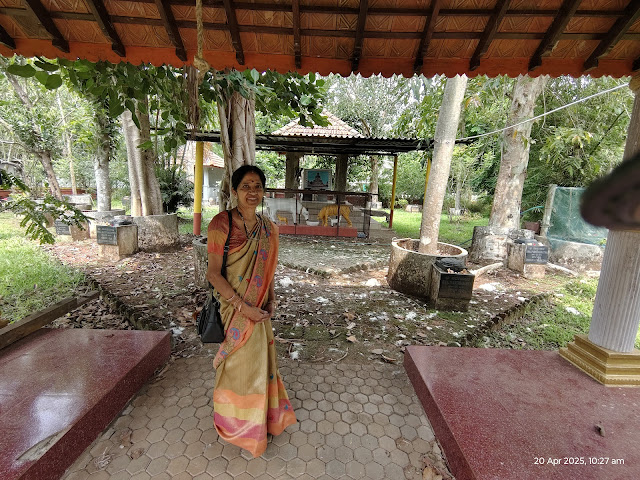Today (20 April 2025) unfolded as a perfect blend of celebration, nature, spirituality, and family bonding. As planned, we set off on a delightful journey to Kuthlur, Naravi, in Belthangadi Taluk, to attend the housewarming ceremony of Kiran, the son-in-law of my brother Dinesh.
🌄 The Journey Begins
Shreemathi and myself started from home at 8:30 AM, driving
through a refreshing green corridor—Manipal – Hiriyadka – Karkala – Bajegoli
– Hosmar – Naravi—finally reaching Surendra Nivasa. The route was a
visual treat, flanked by thick greenery and well-maintained roads, making the
drive smooth and picturesque.
☀️ A Spiritual Stop: Sooryanarayana Temple,
Naravi
Reaching Naravi earlier than expected, we made a spontaneous and rewarding stop at the historic Sri Sooryanarayana Temple, one of the most revered and ancient shrines dedicated to the Sun God in Karnataka.
Situated in a quiet corner of Belthangady Taluk, this
14th-century temple is steeped in history and legend. It is said that Saathvi
Rama Devi, a devout woman from the Ramera Guthu family, received a divine
vision of Lord Surya. Following his guidance, she unearthed his idol near the Suvarna
River and consecrated it in Naravi.
The temple architecture showcases traditional coastal Karnataka
aesthetics—with sloping tiled roofs, ornate wooden interiors, and
a 2.5-foot Rudraksha stone idol of Lord Suryanarayana holding lotus
flowers. A major renovation in 2011 enhanced its charm while preserving its
heritage.
 |
| Nutmug Tree |
 |
| Jain Influence on Nagaradhane in South Kanara in Sooryanarayana Temple |
🛕 Jain Influence in Temple Architecture and Iconography
In several temples across Dakshina Kannada and Udupi districts, one can find intriguing elements that reflect Jain influence, especially in iconography and subsidiary deities. A notable example is the presence of serpent idols (Nāga idols) that resemble Jain Tirthankara images—seated in meditative postures under a hooded snake canopy. Even in Sooryanarayana Temple one can see in the above the same influence of Jain theerthankara.
This fusion likely stems from the region’s rich Jain heritage, particularly during the rule of Alupa kings and other dynasties that patronized Jainism. Many Jain basadis (temples) were established, and the philosophy deeply influenced local art and spiritual practices.
In Hindu temples, particularly those with Nāga shrines, the depiction of serpents in Padmasana (lotus position) with hands in Dhyana mudra and no distinct iconographic weapons or attributes is a strong indicator of Jain symbolism. These are thought to be representations of Tirthankaras, possibly assimilated into local beliefs over time.
This intermingling of Jain and Hindu traditions is a beautiful example of religious harmony and syncretism, where ancient philosophies coexist and enrich one another through architecture, worship, and iconography.
🌿 A Walk Through Tranquility: Shri Anantha Shanti Tirthankara Vana
Just a short walk away lies another spiritual gem—Shri Anantha Shanti Tirthankara Vana, a Jain spiritual garden dedicated to the 24 Tirthankaras. Set amidst lush greenery, the Vana offers a serene space for reflection and mindfulness.
- Life-sized
statues of all 24
Tirthankaras line a circular pathway, each inscribed with their teachings
and symbols.
- The park is
landscaped with flowering plants, fruit trees, and peaceful walking paths.
- Benches and
gazebos allow quiet moments for meditation under the shade of tall trees.
- The layout of
the Vana embodies eco-spiritual themes, echoing Jain values of Ahimsa
and environmental harmony.
Whether you're spiritually inclined or simply a nature lover, this space
offers peace, quiet, and a chance to disconnect from the rush of daily life.
🏡 Housewarming at Surendra Nivasa
Our next stop was Surendra Nivasa, the newly built and
beautifully renovated five-bedroom village house inside a thriving arecanut
plantation. The property is surrounded by a wide variety of trees—mango,
jackfruit, jambunerele, guava, and more—creating a lush, green retreat.
We were warmly welcomed by Kiran’s parents, whose kindness and hospitality made everyone feel at home. They had conducted Vasthu Homa the previous night, and today’s Satyanarayana Pooja was attended by a large gathering of family and villagers. A delicious lunch followed the rituals, served with care and love.
 |
| Sathyanarayana Pooje |
 |
| Sathynarayana Pooje |
A walk through the arecanut garden led us to a large well, full
of water—an impressive structure that my brother Dinesh estimated would
cost around ₹15 lakhs to construct today.
👨👩👧👦 Family Moments to Cherish
It was a joy to meet
several close relatives:
- Somanath Karanth (my brother-in-law) and Kasturi
(his wife)
- Prashanth, son of Shuka
- Srikanth, son of my sister Vedavathi
- Dinesh and Bharathi
Before leaving, we expressed our heartfelt thanks to Rajendra,
Kiran’s father, his mother, and his elderly grandmother for their generosity
and affection.
🛣️ The Journey Back
Our return was equally
pleasant, taking the same route back. Somanath Karanth and Kasturi
accompanied us till Karkala, where they got off at Karkala Bypass
to board a bus to Mangalore. As I was feeling sleepy after festive lunch, I
allowed Shreemathi to drive till home.
We stopped briefly at Athradi weekly market to pick up fresh
vegetables—a vibrant end to our countryside sojourn. By 4:30 PM, we were
back home, our hearts full from a day of spiritual blessings, family love, and
joyful memories.
Final Thoughts:
The visit to Naravi was not just about attending a function. It was a
celebration of tradition, family, and nature—an immersive experience
into the soul of Tulunadu. From ancient temples to spiritual gardens and
warm village hospitality, it reminded us of the richness that lies in our
roots.























No comments:
Post a Comment